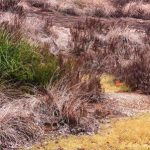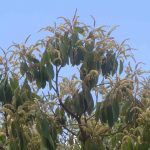TREE LIFE
MARCH & APRIL 1995
Reminders that the 1995/95 subs ($40) are due. Please pay promptly and add $1 for cheques drawn out of Harare.
MASHONALAND CALENDAR
Tuesday 4th April. Botanic Garden Walk at 4.45 for 5 p.m. We will meet Tom in the public car park of the Gardens and by request, look at Terminalia species.
Friday 13th to Tuesday 18th. Have a wonderful Easter and Independence holiday. Nothing has officially been planned for this period.
Saturday 22nd April. Mark’s Walk. Back to a favourite haunt, Domboshawa, an interesting place which we have not by any means exhausted. There is an official at the car park so cars should be safe.
Saturday 28th April to Monday 1st May. Camping at Mazuri Safaris near Ngezi and Sebakwe Dams. The camp site is on the banks of a private dam which attracts abundant bird life and the ranch is well wooded and stocked with game. $25 per person per night. Hot water showers, toilets, braai area and wood supplied. If you would like a camping weekend in the midlands please let Maureen Silva-Jones know by no later than 10th April. As the ranch is equidistant from Bulawayo and Harare, can we entice some Matabele to join us?
Tuesday 2nd May. Botanic Garden Walk.
May 25 to May 28 inclusive: RIFA. We have been fortunate enough to reserve the RIFA Camp near Chirundu for a few days at the end of May 1995 and although fully booked your name can be put on the waiting list in case of cancellations. To book please phone Maureen Silva-Jones.
Those who have confirmed bookings please pay your $325 now, by cheque in favour of the Tree Society.
Sunday 21st May. A.G.M.
NOTICE OF ANNUAL GENERAL MEETING . NOTICE is hereby given that the 45th Annual General Meting of the Tree Society of Zimbabwe will be held on Sunday 21st May 1995 at Templeton Estate, Banket at 10.00 a.m.
AGENDA
1 Notice convening the Meeting
2 apologies
3 Minutes of the 44th A.G.M.
4 Matters Arising
5 Chairman’s Report
6 Treasurer’s Report
7 Election of Committee Members
8 Any Other Business
Any proposals/resolutions and nominations for office-bearers should be forwarded to P 0 Box 2123 Harare by Monday 8th May if possible, although proposals and nominations will be accepted from the floor.
We plead again for volunteers to join the Committee, the pay is lousy but we do have fun and we NEED FRESH IDEAS AND TALENTS.
MATABELELAND CALENDAR
Sunday 2nd April. To the Bickle family farm to look at Acacias and veld Management. We depart PROMPTLY at 8.30 a.m. from the Girls’ College car park.
Monday 3rd April. A.G.M. and video at Girls’ College at 7.30 p.m. Tea and biscuits will be served.
OBITUARY
CHARLES SYKES died suddenly on 1 March 1995. He was doing what he probably liked most of all – botanizing on his early morning walk – when he suffered a massive heart attack.
Charles was an Oxford man. He did classics and this stood him in great stead with the nomenclature of plants. He was always keen to explain meanings and pronunciations of botanical names and this allied to a profound knowledge of the Zimbabwean bush made him a great teacher. We all at one time or another learned (and argued, for he was a great one for debate) much at his side on our tree walks.
Charles was Secretary of the Bulawayo Branch for 7 years.
We shall miss him very much.
-Ian McCausland
KLOOF FARM, NYAMANDHLOVU. MARCH 1995
It was a bright, sunny morning, too bright and sunny in drought-stricken Matabeleland for our liking, when our small convoy of seven vehicles set off up the Falls Road to turn off on to the Nyamandhlovu Road and arrive at Anne Visser’s ‘Kloof Farm’ some 22 kilometres from town. Anne was busy having what looked like a potentially explosive altercation with a horse which caused me to make a cautious circle around the better side of the angry recalcitrant incumbent in order to greet her.
Having satisfactorily handed the snorting equus over to a groom, Anne then welcomed us and suggested we go round the back of the hill which runs through the farm. Having collected her three excited, bounding tail-waggers we set off for the portion of the farm to be explored.
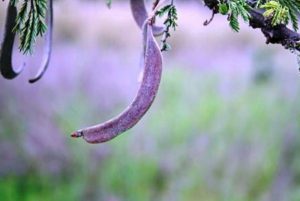
Acacia gerrardii. Photo: Mark Hyde. Source: Flora of Zimbabwe
Arriving on site, Ian explained that we were visiting an ancient sedimentary complex which includes sandstones, basalt and Kalahari sand. Leaving the latter behind us for the time being we made our way up the hill, Emnyama, at a typically leisurely and diagnostic Tree Society pace. We found a lot of old friends on the way – Acacia fleckii, Acacia galpinii, Acacia gerrardii, Acacia nigrescens, Acacia nilotica and Acacia rehmanniana. The Acacia nigrescens were particularly lovely here as their proportions were generous and they tended to group. They are definitely my favourite acacias.
Then there were Albizia amara, Azanza garckeana, Bridelia mollis, Burkea africana, Cassia abbreviata, Clerodendrum matabelica, Clerodendrum glabrum, Colophospermum mopane, Combretum apiculatum, Combretum collinum, Combretum hereroense, Combretum molle and a host of Commiphora including Commiphora africana, Commiphora mollis, Commiphora mossambicensis and Commiphora pyracanthoides. There was a particularly splendid group of Commiphora mossambicensis with its spring-like fresh green leaves which drew our admiration.
Also on the hill were Diplorhynchus condylocarpon, Dombeya rotundifolia, Ficus ingens, Ficus thonningii, Flacourtia indica and masses of Flueggea virosa.
Grewia flavescens (still flowering) and Grewia monticola. Lots of Ormocarpum trichocarpum in full flower and Cissus cornifolia filling in the undergrowth.
Ozoroa revived a much repeated discussion as far as I am concerned as I have always called it Ozoroa paniculosa but other members insist it is Ozoroa insignis. KCP states that the latter is found only in Namibia. Anyway insignis or Ozoroa paniculosa, they were there. Not in large numbers but well distributed.
The well-wooded kopjie having provided us with a lot of species, even far more than 2 have already mentioned above, we felt that a tea break would be welcome. On the way down we still found Pseudolachnostylis maprouneifolia, some Kirkia, Lannea discolor, Pterocarpus and Terminalia.
During tea, Anne described the fast-growing and green-burning propensities of Acacia fleckii and suggested that it may be a good tree for rapid re-afforestation. After tea, we walked over to the western side of the farm on to sandveld and suddenly found ourselves in teak woodland. Here and there we found a Baikiaea plurijuga still in flower although I understand they have not flowered well this year, no doubt due to the drought. Many other trees have been similarly reluctant about flowering. There on the sandveld we found Combretum psidioides, Ochna pulchra, Pavetta schumanniana, Acacia erioloba and Vangueria infausta.
This rounded off yet another memorable visit to Kloof Farm and we will take Anne Visser up on her stated intention of joining the Tree Society.
-Clem van Vliet
Buchwa Mountain February 1995
Mount Buchwa rises out of the Lundi plain, like a jagged dinosaur’s backbone, 50km southeast of Zvishavane. About 9km long, it runs east-west, reaches a height of about 700 m above the surrounding countryside and is visible from a huge distance. Halfway along the mountain, there are vast rock screes which stretch from the ridge top to the valley floor, on both the north and south sides, the legacy of iron ore extraction.
I always think what a thrill it must have been for the earlier trekkers in their ox wagons, when it took days to approach a mountain and they must have seen it looming larger day by day.
Buchwa is similar to Wedza, Bikita and Great Zimbabwe, in that it lies in the mist belt, hence the unusual vegetation. The concrete road with its many hairpin bends, passes much devastation from surface mining on the lower slopes but then winds up through Brachystegia glaucescens woodland. A tunnel through the very top of the ridge and then we were driving round the rim of a giant crater. The entire crest of the mountain has been removed leaving two pyramid-like faces of red rock, cut in a step-wise fashion. From the crusher, a three storey, corrugated iron affair, the conveyor belt takes the rock down the entire mountain side, (supported on pylons occasionally), under the main road and another kilometre or so across the valley floor to the railway siding. Ore has not been mined for the last two years; but they are re-opening shortly.
In whipping wind and guti we traversed around the pit and hauled ourselves up on to the far ridge. A plastic coated cable provided welcome moral support as there was loose rock underfoot and dramatic drops on both sides. We then followed an old road along the mountain top towards the western end. Finally the vegetation – the early section was much like Cecil Kop range behind Mutare, with Protea, Faurea, Myrica, Phillipia, Nuxia and Aloe species. There was wonderful lichen, orange, with wine glass type fruiting bodies and several rocky promontories where the moss was dripping wet.
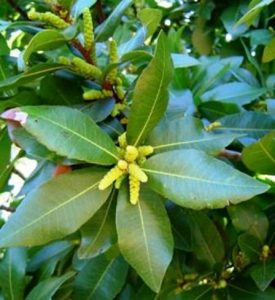
Myrica pilulifera. Photo: Bart Wursten. Source: Flora of Zimbabwe
The latter section appeared drier, perhaps just because the sun was now out, but the huge Msasas were festooned with moss, ferns, peperonia and orchids. We came across Schrebera alata in flower, a huge Myrica pilulifera with a trunk about a metre across and a hybrid between Aloe arborescens and Aloe excelsa.
The most memorable part of the day was the view that afternoon. Belingwe mountain, a similar height to ourselves in the west, to the north the mine tips of Gaths Mine, a mountain just outside Masvingo, with the high ground of Bikita behind, innumerable hills, the Nyoni Range amongst them. Towards Ngundu halt and in the direction of Chiredzi. Finally right below us, the granite domes around the mission station at Mtibi. (I have since come across a photo of one of these, called Sugar Loaf, in a book on the Pioneer column; it is shown as standing at the confluence of the Ngezi and Lundi Rivers.
On the trip down I was in Jonathan Timberlake’s vehicle and we stopped to photograph root profiles on the road cuttings. Jonathan was pleased to get a record of Brachystegia glaucescens roots and to see them so similar to those of Julbernardia and Brachystegia spiciformis. There is usually a large lateral root which branches, at right angles from the tap root about 20 cm below ground level and travels horizontally. Another comes off at a depth of about one metre and so on. I was interested to hear how this accounts for the lack of vegetation beneath Brachystegia trees, competition for water preventing all but grasses from growing. Apparently on Kalahari sand much grows beneath the teak trees, because Baikiaea has a core of roots which once the tree is established, only absorb through the root hairs at the tips which could be 3 to 4 metres below ground.
Our thanks to the Bulawayo contingent for organizing accommodation, access to the mountain and the opportunity to visit this exciting part of the country.
BUCHWA
On Friday February 2, 1985; leaving Girls’ College somewhat after noon, the members of the Bulawayo Tree Society travelled through Zvishavane to Buchwa Mines, 280 kilometres, to meet with the Tree Society of Harare members. The combined group stayed at the Buchwa Mines Club which supplied good food, good sleeping quarters at extremely reasonable rates.
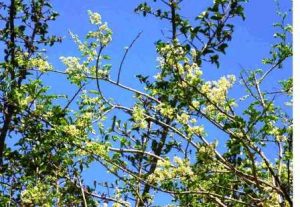
Dalbergia melanoxylon. Photo: Bart Wursten. Source: Flora of Zimbabwe
On our original turn off to Buchwa, a few Adansonia digitata specimens were seen followed by many Combretum adenogonium bushes, Dalbergia melanoxylon, and Diospyros mespiliformis. Then, on arriving at the Country Club, Combretum zeyheri, Brachystegia boehmii, and Brachystegia spiciformis (many leaflet sizes, leaflet texture and even leaflet deviation from the usual number). Julbernardia globiflora trees were numerous throughout the entire area, some in flower, the whole upper part of tree being prominent, with the Albescent stamina. Also, Parinari curatellifolia was seen frequently throughout our three day trip.
Saturday, after an early breakfast, the combined group drove to near the upper part of the mountain, on the wet side, breaking up into two groups. 0ne group, the energetic and brave, successfully circled the end of the mountain. Our group, with periodic vertigo, knee arthralgia, and acrophobia, remained in more respectful areas, meandering down the mountain road, stopping frequently to examine the flora. On our peripatetic wanderings we discovered many Vernonia specimens with dried sepals, numerous Rhus chirindensis, Heteropyxis dehniae, Ficus natalensis, Terminalia gazensis, Albizia adianthifolia, Nuxia congesta and Dombeya burgessiae, acting as canopy over other plants, with striking pink petals. Many Aloe arborescens were encountered early on. Stopping at the gate up the mountain road, we found Acacia polyacantha, Acacia karroo, Acacia nilotica and Gardenia ternifolia. Further down to the flats, we discovered Coddia rudis, Catha edulis, Pterocarpus rotundifolius, Pappea capensis, Ormocarpum trichocarpum, Maytenus senegalensis, Grewia flavescens, Margaritaria discoidea, Rothmannia fischeri and Berchemia discolor.
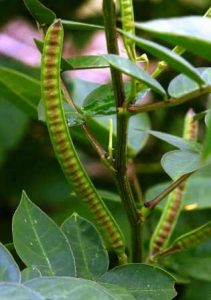
Senna occidentalis. Photo: Bart Wursten. Source: Flora of Zimbabwe
A new aspect of tree search was delightfully exposed by Hark Hyde, following in footsteps of Bob Drummond, so that all botanical specimens exposing themselves, ranging from the lowly prostrate Alternanthera pungens (or was it Alternanthera caracasana?) to the magnificent Anomatheca grandiflora were critically appraised. Aromatic Tagetes minuta and Tidrax procumbens, weeds from South America and widely spread were examined with the same care as the beautiful Senna occidentalis and blue Wahlenbergia (much larger than those seen last year in Bulawayo area).
Throughout Saturday and Sunday, flowers, as well as trees, were found and examined, from one lonely Tricliceras longepedunculatum to Asphilia mossambicensis, Bidens pilosa and Tridentata. And many others, such as Sida specimens, specimens from Acanthaceae family, wild basil (Ocimum) and most spectacular of all, a Eulophia, species unknown, hidden in the deep shade.
One group then drove to a close by area where there was a mission. Close by, a small mountain was climbed to a cave, encountering Stadmania oppositifolia (a new specimen), along with Friesodielsia obovata in flower, Grewia flavescens in flower and Lannea schweinfurthii in fruit, with long stalks, ripe enough to eat and enjoy.
On Sunday we drove through another gate, finding Combretum microphyllum and Combretum mossambicense (often together) followed by Ehretia amoena with large leaves, being in fruit with many red berries, so spectacular that photos were taken by our Harare friends. We then travelled to opposite side of Buchwa, the dry side, finding Calpurnia aurea, Ekebergia capensis and others.
Parking under mango trees, we ascended a mountain with a small stream, to find extensive members of Terminalia gazensis, escaped Psidium guajava, Zanthoxylum capense, Dovyalis zeyheri, Rauvolfia caffra, Mimusops zeyheri, Dodonaea angustifolia, Ximenia caffra and Diospyros lycioides. This later was found in fruit, red and soft and round with sepals retroflexed, explaining the common name ‘red star apple’.
The active people encountered Antidesma venosum, Antidesma membranaceum, Oxyanthus speciosus, Bridelia cathartica, Strychnos usambarensis, Apodytes dimidiata, Cussonia spicata, Aloe excelsa and Ekebergia benguelensis.
Other trees found were Brachystegia glaucescens, Acacia galpinii, Acacia robusta, Acacia rehmanniana, Afzelia quanzensis, Albizia harveyi, Albizia versicolor, Azanza garckeana, Balanites aegyptiaca. Bequaertiodendron magalismontanum, Brachylaena rotundata, Bridelia mollis, Carissa edulis, Celtis africana, Clausena anisata, Combretum molle, Cussonia arborea, Dichrostachys cinerea, Diospyros whyteana, Faurea saligna, Euclea crispa, Euclea divinorum and Flueggea virosa. Many fig trees were seen e.g. Ficus glumosa, Ficus ingens, Ficus sur and Ficus thonningii.
No Commiphora trees were encountered in this area. Other trees seen by different members were Trema orientalis, Uapaca kirkiana, Tarenna neurophylla, Schrebera alata, Sclerocarya birrea, Psydrax livida, Rhus leptodictya, Syzygium cordatum, Ochna schweinfurthiana, Ozoroa insignis and Peltophorum africanum. Myrica pilulifera and some species of Allophylus were also examined. We could not differentiate the exact species.
Having scrutinized numerous botanical specimens over two days we returned to Bulawayo feeling that we had greatly added to our knowledge of trees and flowers. And looking forward to following the material removed, causing a big defect in the mountain, to its ultimate distinction and thus to look into a new science, metallurgy.
-Tom Raub
NYARUPINDA CATCHMENT March 1995
Winter Retrospect’s
To recapture the feeling of winter 1994 in Zimbabwe please read again the contribution by Ian McCausland on pages 2 and 3 in Tree Life No. 174.
Here are some ground temperatures in degrees Celsius recorded on the Meteorological Services map for July 1994, Chipinge –3.5°, Gweru –7.6°, Nyanga –3.4°, Rusape –6°, and a subzero temperature at Victoria Falls –2.2°.
FROST Part 4 Trees and Frost
There was a bigger freeze 26 years ago in June 1963; it was the severest and most widespread for at least 40 years. In the main commercial tree growing areas in the Eastern Districts, Inyanga had 23 degrees of frost i.e. 9°F and 12 degrees of frost i.e. 20°C at Melsetter. Eucalyptus of various species, of heights from 1 ft up to 100 ft had their foliage damaged, split bark and spongy bark was mentioned in three reports received by the Forestry Commission staff headed by P.F. Banks.
Assessment of Frost Damage on Trees
The following information is needed to assess damage:
1. Identify and describe the tree giving its scientific or other name, height, age (young, mature or senile) and state of growth i.e. actively growing, quiescent but not dormant, dormant.
2. Type of damage: observe the condition of branch tips and leaders, crown, all foliage, buds and fruits as regards being blackened, russet or scorched. The appearance of stems, crotch, branches and trunk that may have split bark or frost canker which is the killing of bark and cambium of sharp-angled crotches where the wood and bark is immature as compared with that of trunk and branches.
Note the condition of those parts above the injury, have they starved and died back? The rapidly grown parts of plants are frost tender.
3. Situation of the Tree: valley bottom, moderate or steep slopes or level area. The elevation of the site and whether exposed to the elements, often a difference of a metre or two in elevation is responsible for frost at a lower level due to the gradual settling of cooler, heavier air.
4. Frequency and Extent of Damage observation reveals that trees of the same species, age, condition and situation are not similarly affected by frost. The injury is related to the tree’s inherent susceptibility to frost (or its frost hardiness) as well as to the seasonal composition of its cell sap; the more dilute the sap the more likely it is to freeze.
What do you think about this statement …frost damage is compounded by drought conditions, is it a fallacy?
Here are a few observations gathered from far and near.
Along the banks of the Mupfure river large Msasas and thorn trees succumbed to frost in 1994, previously only the small thorn trees had died. The silhouette of Sycamore fig has changed since the frosts, their leaves and branchlets died back. Resumption of growth in early November, as a result of good rains in October, was from undamaged dormant buds all along the main branches.
Ian Barren of Gomo Estate said that he had noticed the smell of cooking vegetables in the garden later in the day after a black frost in the early hours of the morning. To my mind the explanation for this is on page 5 in Tree Life No. 178, look for the Cellular Basis of Freezing Damage. The ice crystals grew and grew by withdrawal of water from the surrounding cells which became shrunken and the leaves wilted when the light of the sun melted the ice, the odour came from the sun-sweated leaves. This can be likened to the method of cooking spinach in its own moisture.
Wind frost was widespread on high ground and exposed places, developing “cherries” in the coffee plantations around Chipinge were damaged, and they were saleable but downgraded. This icy wind blew from the Antarctic, it was an advective frost. At Erene Farm in Marondera area Tree Walkers noticed damage to the tops of trees, their lower branches were unaffected. On termitaria in the Ayrshire district all the tall wild Bauhinia were wind-scorched, their leaves hung on for months because life stopped before the time for abscission. The willows Salix mucronata in the Nyarupinda riverbed were actively growing and green throughout the winter, whereas regrowth in Brachystegia woodland nearby was brown and crisp. On the broad crest of land overlooking this river the banana plantation caught the frost; this resulted in the reduction of the leafy canopy which is so necessary to protect the developing bunches of fruit from sun-scorch. Many bunches showed false ripening in the absence of shade.
Chilling and slight frosts are beneficial to some plants. A degree or two above or below freezing point improves the quality of brussel sprouts; larkspur seeds need a cold spell before it will germinate. Furthermore, an important aspect of pomology is that deciduous fruit trees (peach, plum, pear, apple etc) need a period of chilling in the winter to ripen their wood and promote dormancy in order to produce good growth of both foliage and fruit the following season.
Andy Mac this is the end of the series of articles on Frost and its Effects on Plants.
Part 1 Ground Temperatures and Frost – Tree Life No. 176 Page 5
Part 2 Topography and the Incidence of Frost – Tree Life No. 177 Page 4
Part 3 Cellular Basis of Freezing Damage – Tree Life No. 178 Page 5
Part 4 Trees and Frost – Tree Life No. 182
Extra Reading – The Natural History of Selborne by Gilbert White.
The origin of the word Pomology is POMONA a Roman goddess of fruit and fruit trees. A book greatly valued in England is the Herefordshire Pomona which is a finely illustrated treatise on pome fruits. Endearments and loving glances may have been exchanged over the quinces and pearmains in the library at Wye (agricultural) College in Kent; for, in due course the elderly fruit-grower, Mr. Bagenal …yes, Baggy married the comely librarian and they lived happily ever after.
“Adieu, Adieu to you… and you… and you-oo.”
-Benedicta Graves
CAVE YIELDS CLUES TO AFRICAN MAGIC
By Norman Hammon, Archaeology Correspondent
Evidence of prehistoric magical rituals has been found in a cave in central Africa. The remains of plants having reputed magical properties indicate that body-painting and the manufacture of poison arrows were among the activities carried out.
The Paouan Cave, near Lastoursville in Gabon, has yielded evidence of occupation between 5,600 and 4,000 years ago, according to Richard Ogisly and his colleagues. Stone tools found were of types widespread in Zaire and the Congo as well as Gabon, made from jasper and quartz.
Charcoal found in the excavations derived from only four species of plant, indicating that the choice of those carried into the cave was highly selective: more than a thousand species grow in Gabon. All four are well known to the modern inhabitants of the Ogooue valley as having magical or ritual properties.
One was a tree which yields a red powder used as a body pigment, especially during initiation rites; another was the resinous Copaifera, known as the “king of trees” and used to make torches to light the interior of the cave’s vast chamber. A third tree species, Combretum, yields a very hard wood used for making battle-clubs.
The fourth plant was a liana used by many African tribes as a source of arrow poison, and also as a tonicardiac during periods of violent exercise such as prolonged ceremonies. The presence of this Strophanthus vine and worked stone “suggests that poison arrows ware manufactured in the cave”, the investigators say. “Poison-arrow manufacture by many African tribes is carried out with elaborate ritual in secret places such as caves, from which women are excluded. The choice of Copaifera resin as the preferred torch-making material, and of Pterocarpus tinctorius for its red pigment accords with the view that Paouan cave was used for magical ritual purposes.
“It seems that by 5,600 years ago, some of the tribes of tropical Africa had mastered the art of poison-arrow manufacture, and that they had developed elaborate rituals around this activity.”
Source: Nature 367: 25-26 From the Times of London
ANDY MACNAUGHTAN CHAIRMAN


